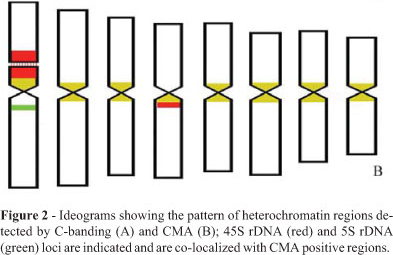The chromosomes of Crotalaria juncea, a legume of agronomic interest with a 2n = 16 karyotype composed of metacentric chromosomes, were analyzed using several cytogenetic techniques. C-banding revealed heterochromatic regions around the centromeres in all chromosomes and adjacent to the secondary constriction on the chromosome 1 short arm. Fluorescent staining with the GC-specific chromomycin A3 (CMA) highlighted these heterochromatic regions and a tiny site on the chromosome 1 long arm while the AT-specific stain 4'-6-diamidino-2-phenylindole (DAPI) induced a reversed pattern. Staining with CMA combined with AT-specific distamycin A (DA) counterstaining quenched the pericentromeric regions of all chromosomes, but enhanced fluorescence was observed at the heterochromatic regions around the secondary constriction and on the long arms of chromosomes 1 and 4. Fluorescence in situ hybridization (FISH) revealed 18S-5.8S-26S rRNA gene sites (45S rDNA) on chromosomes 1 and 4, and one 5S rDNA locus on chromosome 1. All the rDNA sites were co-located with the positive-CMA/DA bands, suggesting they were very rich in GC. Silver staining revealed signals at the main 45S rDNA locus on chromosome 1 and, in some cells, chromosome 4 was labeled. Two small nucleoli were detected in a few interphase cells, suggesting that the minor site on chromosome 4 could be active at some stages of the cell cycle.
Crotalaria juncea karyotype; C-bands; fluorescent banding; FISH; rDNA sites; Ag-NOR









